Animals in Aobayama
Animals
●Ootaka (washitaka famiky)
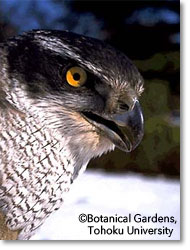
The total length is about 60cm, the back is an ash black, the white feather has mixed with back of the head, and spots like a long eyebrow are in the face. The character is brave, quick, power to fly is strong. So he was used for hunting for a long time. The breeding season is May-June, and the aerie is chiefly built in a big tree such as the pines. This is specified for domestic scarce, wild flora and fauna in " Law for the Conservation of Endangered Species of Wild Fauna and Flora ", and capture is prohibited. This inhabits a mountain of Honshu and Shikoku, and the forest of the foot of a mountain district.
●Hayabusa (Hayabusa family)
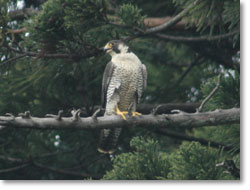
The total length is about 50cm, and upper part of the head, back of the head, circumference of eyes, and part of the throat from the nib are the blacks, and the back is a gray, and dark color horizontal spots are a little lightly in waist and feather with which the upper surface of the rectrix is covered. This is seen in the uncultivated field, the waterside, the cliff ground, arable land, and the urban area, etc., and is not seen so much in the forest. The flight power is strong, and when food is found, this shuts the wing in the air, dives, and attacks it. This is almost distributed all over the world, and this inhabits the whole country as a winter bird or a migrant.
●Fukurou (Fukurou family)
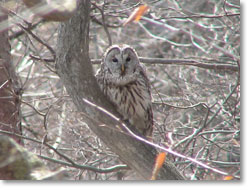
The total length is about 50cm, and there is a zonal ash gray and remarkable brown spots in the back, and some horizontal belts are in the rectrix. This reaches the uncultivated field, etc. at nighttime, and this preys on the rat etc. though this is asleep in daytime in the forest. The breeding season is in March-May, and eggs are laid in the cave of the large tree and hawk's old aerie, etc. This inhabits Kyushu from Hokkaido.
●Yamagara (shijyuukara family)
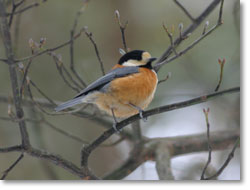
The total length is about 15cm, and face, forehead, center in the upper part of the head, belly, and root of the tail are belting brown, and the neck back and the belly side are nut-brown. This is a resident bird to live a lot in the whole country, and this inhabits chiefly in the woods. But, this goes out to the foot in winter. This is easy to keep, and is kept well for a long time. This twitters, saying that "Tsutsuti Tsutsuti".
●Kamoshika (Ushi family)
(no image)
The total length is about 140cm and this is usually a dark brown color. But, most is an ash gray in Iwate, Miyagi and Fukushima Prefecture. This is a high mountain beast that inhabits the mountains provinces of Honshu, Shikoku and Kyushu and specified for the natural monument in the country. This inhabits solitarily meadow and craggy mountain, and gives birth to one at a time in April-June. This seems to eat woods and leaves though this is herbivorous.
●Kitsune (Inu family)
(no image)
The total length is about 100cm, and the head is a shade tan, and the body is slightly light brown. "Kitakitsne" in Hokkaido is subspecies of "Fox" to live from Honshu to Kyushu. This is nocturnal, sleeps in the hole in daytime, and inhabits the plain and the forest. This gives birth to 2-9 at a time in March-May.
●Tanuki (Inu family)
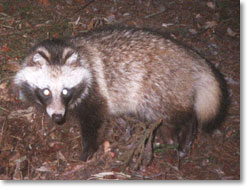
The total length is about 70cm, and this inhabits Kyushu from Honshu. This is nocturnal, inhabits other animals' holes in daytime, and occasionally, several inhabits together. This is seen in the mountainous district and the vicinity of the house, and witnessed still sometimes in the town. Entering the state of apparent death by shock is famous, This is said, "Tanukineiri (feign sleep)".
●Touhokusanshouuo (sanshouuo family)
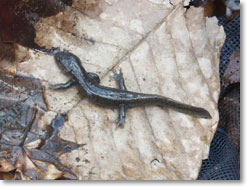
The total length is about 10cm, the back is puce and covered with the macula of the dark color or the light color. The tail is longer than trunk, and becomes remarkably flat while going to the rear side. The egg laying is in March-May. The egg is laid on the stone and the tree branches such as the brooklet and spring water in the ravine. This inhabits the Honshu area north of Niigata and Fukushima prefectures.
-Reference book : "New Japanese animal(under)", written by Kaname Okada, Hokuryukan
Copyright 1996-2010 Tohoku University All Rights Reserved.







